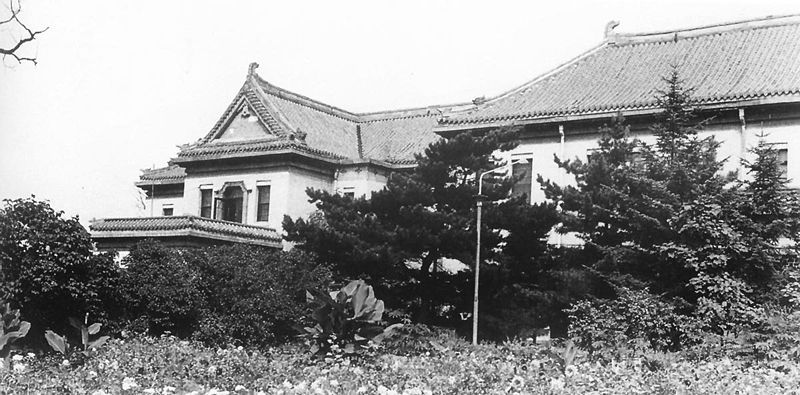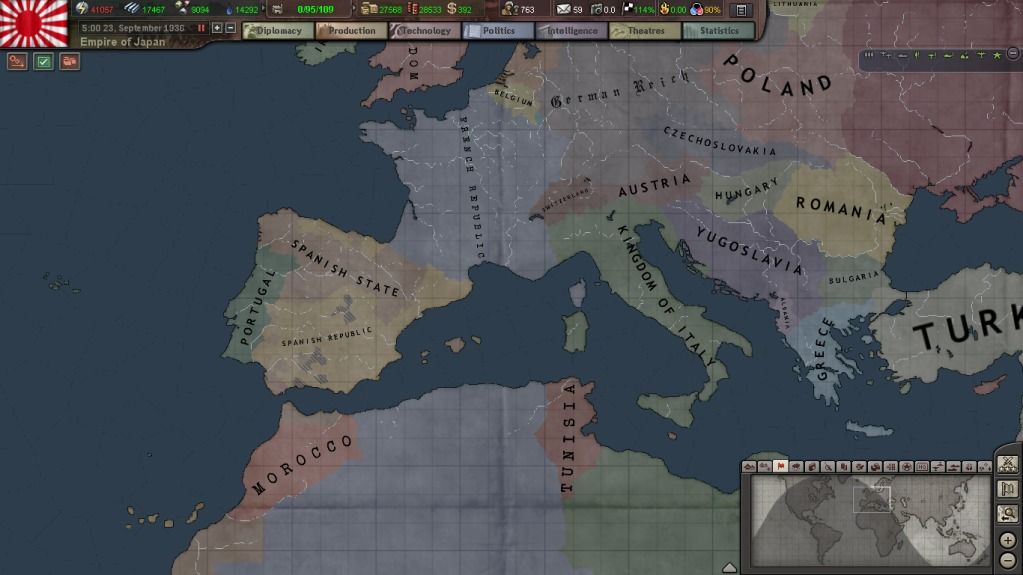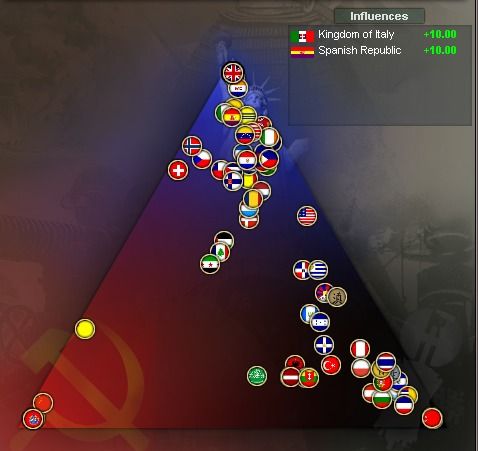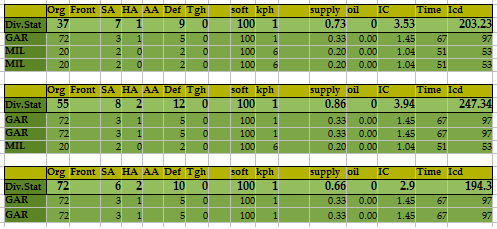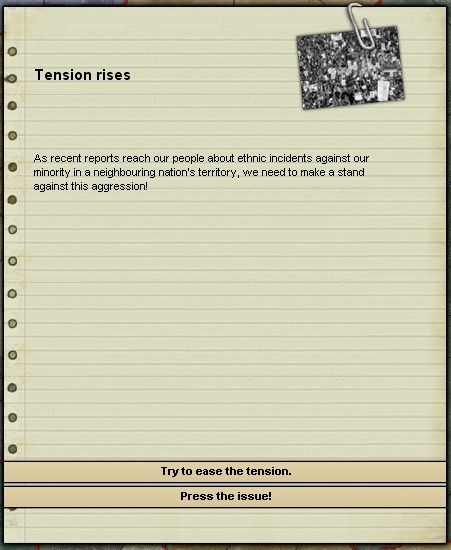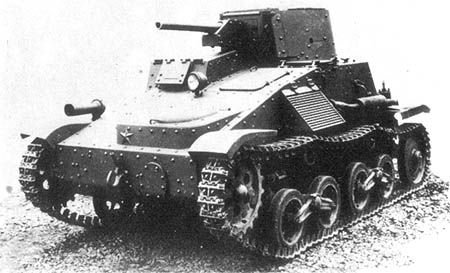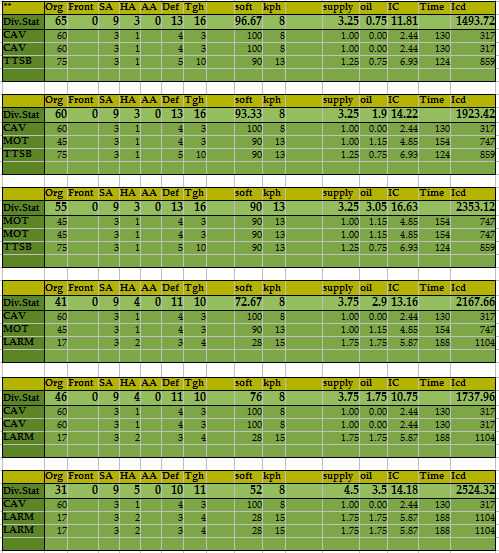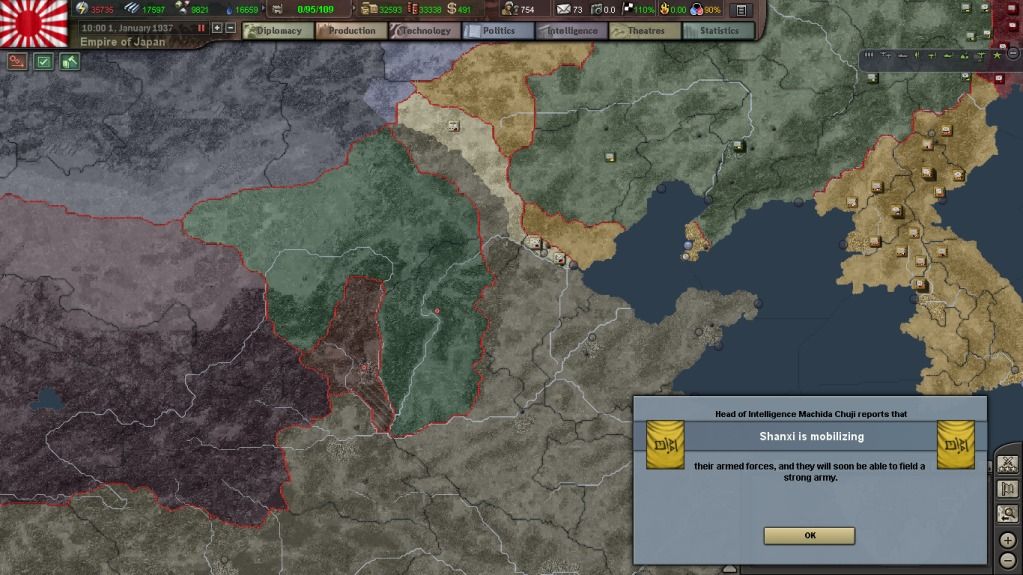The Imperial Palace of the Manchu State, residence to Pu Yi since 1934
The Military Strikes Back
Aug 1936 – Jan 1937
In the first days of August the Imperial Japanese Army (IJA) made its move, with its response to Pu Yi's stand. In the early hours of dawn 1,783 soldiers acting under the decision of Count Hisaichi occupied the grounds surrounding the Regents palace in Changchun, Jilin province.
Meanwhile numerous other groups acting under orders from him took control of Manchu barracks in Mukden and Harbin. In the countryside cavalry units moved to make a presence in Huludao, Anshan, Dangdong and Fushun to hold imports from Japan into Manchuria during this 'incident'.
The move was unilateral within the armed forces, although many suspected the Emperors complicity in the actions, and only Manchida Chuji the intelligence and armaments minister would openly condemn the use of the armed forces in reasserting the JCGs will upon the Manchu regime.
In this bloodless show of power it was clear that the Imperial will was to be done; blockading the Regents privileges momentarily to enforce the change of policy. This act would fundamentally change the relation between the Emperor and the Diet, as it showed that even though their had been constitutional change the Emperor and the armed forces could and would still act unilaterally in matters of foreign policy without the full support of the public.
While the new JCG had not broken any constitutional limits, the overwatch of Imperial troops would leave a sour taste in many Manchu and Japanese minds for many months to come. Within Manchuria itself the view was very different, with soldiers openly celebratory that the Emperor had not caved to Pu Yi's pressure and that as far as they were concerned little had changed from the Japanese regime change.
Soldiers celibate having taken over government officers in Mukden
The View From Europe:
In during the summer of 1936, French diplomats had courted the new JCG several times under the guise of improving, or repairing, Franco-Japanese trade relations. Although American foreign observers commented that France might have been looking for a more solid position with regards to Japanese ambitions in the pacific and possibly be looking to keep Japan pally with France in case the trouble in Spain and the looming threats from Hitler might materialise into something a bit more involved. From the JCG position this was a welcome course of events, bringing money and influence causing the two nations to drift closer together diplomatically.
Indeed, the french president might have been right to worry, as from the beginning of september till the 23rd of the month, tensions had been growing in Spain, eventually reaching a boiling point that sparked into a full civil war.
Map of Spain and North Africa at the beginning of the SCW, Morocco and Tunis being two of France's recently 'liberated' nations.
Several European nations were quick to support either side adding to the conflagration, starting with the Soviet Union, and then Italy and Germany. Who recently along with Hungary and the Republic of China had signed the Anti-Comintern pact.
This pact stated; "recognizing that the aim of the Communist International, known as the Comintern, is to disintegrate and subdue existing States by all the means at its command; convinced that the toleration of interference by the Communist International in the internal affairs of the nations not only endangers their internal peace and social well‑being, but is also a menace to the peace of the world desirous of co‑operating in the defence against Communist subversive activities"
Aiming to be a defensive pact in which the participating parties would come to each others aid in the event of a Soviet attack on any of the states. Originally it had been proposed in 1935, where lack of interest from China had prevented it from coming into force.
At the time their were fears in the JCG that the participation of China within this pact at this critical time might be a sign that what the Chinese were really after was an allience with Germany and Italy. The reasoning being Germany would wish to regain her lost colonial territories that Japan had taken in the Great War, and Italy would have the navy and east African bases to aid in this endeavour. In return China had a mineral wealth which could be shipped to Europe.
Thus within the JCG there was a real fear that Chiangs Kuomintang government rather than wishing to aid her European allies, was trying to twist the pact into an alliance along a 'Berlin-Shanghai Axis'.
In many ways, this breaking news covered up much of the negative press coming out of Manchuria against the Japanese hardly impacting Japanese foreign relations there.
In America it was a different story, American-Japanese relations took a minor dive over these actions and much of the American press wasn't keen to paint Japan in a good light, portraying the Japanese as sub-human barbarians, a phrase more common to come out of Nazi Germany at the time, thus it looked to many that America was slowly drifting towards becoming a fascist state. Another worry for the JCG, as much of Japan’s oil came from America, and if the United States aligned with China against Japan, Japan would be left in a difficult position.
Haysashi's diplomatic triangle portraying the nations of the world and their alignments to various ideological groups
The Home Guard:
While abroad the world looked ever less secure it was a political victory that the JCG had taken the hard decision to invest in a Kempeitai gendarme. These paramilitary organisations were Japans new police and home guard force, given military training and sworn to protect the Emperors government, they were technically part of the millitary organisational structure. Practically these garrisons were tied to specific regions of Japan or Korea and lacked any form of mobility or authority to move out of their city or port bases.
There had been some change of plans in the exact composition of the Kempeitai. Initially they would have been local militia volunteers to be led by units of military police acting as judiciary, while the militia would provide the manpower for policing operations in the field.
Such military police units as proposed could not be trained under the existing system, and so a compromise at using both military garrisons and militia had been suggested. In the end however Goto Fumio, minister for security opted for another outlay, instead of recruiting volunteers with low organisation and maturity, it was decided to use two units of garrison forces, one which would act for military matters, and the other for civilian issues.
These garrisons would be little more than a token home guard in any military operations, but they would provide the necessary civil protection to guard important supply lines and act as an early warning force in defence.
Possible Kempeitai divisional structures
Already Japan possessed in the region of 12 non-island garrisons in Korea, and the first 10 new divisions were ready before the end of 1936, being deployed to urban and port centers in the home islands. Another 20 divisions in total were to be raised, and this would be achieved by the summer of 1937 it was estimated. Many of these garrisons would see service in Manchuria replacing exsiting army divisions on supply nodes, or along the long borders. Finally a number would be kept as reserve in the home islands in the event of war or civil unrest. These would then be deployed to where they would be needed.
Islands garrisons were somewhat different, lacking large civil populations, their would be no need for a large civil force. Instead this branch of the Kempeitai divisions would be replaced with milita forces.
The admiralty complained at this move in November 1936, even though these were the islands current garrisons! Overrall the pacific islands were poorly guarded. While their was much talk of turning Truk into a Japanese 'Peal Harbour' their were also calls for Saipan to be this base. In the end the civil government overruled milltiary spending here, arguing that the navy already had many ships on its budget books and it would not be able to justify the extra expense when the situation on the mainland was changing.
Matters of a Martial nature:
On the 25th of October there had been a situation on the Soviet-manchu border, where reports of about ethic incidents against the minority Japanese in the Soviet Unions territories. The foreign minister was keen to press the issue and make a stand against this aggression.
Eventually this of course came back to the Japanese Armed forces in how they were equip to project a credible threat back to the Soviets to make them take these voices seriously.
The IJA historically had seen massive development since the beginning of the Meiji Era and was a fairly modern force, sporting a fully motorised support brigade force, of both mechanised armoured scout cars and tankettes, and of truck-towed artillery and anti-aircraft guns. Although the mud of northern Manchuria still meant that in practice this equipment would be man-hauled to location; the terrain lacking half the roads of Europe or America.
These 13 brigades of armoured cars and tankettes had been a failed experiment of the early 1930s. Following the British development of the MK VI tankette the previous regime had invested heavily in tankette research as the Chinese possessing little anti-tank equipment or heavy machine-guns could not piece even the thinnest armour. Thus a school of thought was born to develop these vehicles for rolls of reconnaissance and infantry support.
Dubbed 'special tractors' they were to be mainly deployed in independent companies, and each Japanese infantry division was meant to have its own tankette company. In principle the Kwangtung theater commanders had spread these mechanised units about the entire order of battle and they lacked any real role within the armed forces.
The new JCG under the Emperor had order a total reorganisation of the armed forces. In part this was to stir up the establishment against any further coups, but also to establish roles for equipment.
The Type 94 Tankette that made up the majority of these mechanised divisions was a massive hog of supplies and oil, which in the far wildes of Siberia would have been more of a liability, and the commanders knew this to a degree. Thus following the 2nd Vladivostok Incident, 11 out of the 13 mechanised brigades were returned to the home islands pending a new outfitting for use in the future when they could support heavier mechanised equipment.
A Japanese Type 94 tankette armoured transport, sporting a 37mm gun.
A second major component of the standing Japanese army was its cavalry divisions. In Korea and Manchuria these divisions had performed outstandingly, more from shock against a poorly trained, or equip Chinese force. Still, about 1/4th of the Japanese Army was a mounted force.
Deliberation on how cavalry was to be used was a fair question during the fall period where various divisional structures were considered. Having pursued several organisational structures in late 1936, combining caverly with mobile support regiments appeared to give the best operational outlay, while keeping supply consumption fairly low.
Cavalry Divisional Structures
With light tanks having become yet another failing in their poor quality due to the doctrines of the early 1930s, Japan's army wouldn't at this time have a decent exploitation corps and would not look to mobile tank forces on the field.
This fitted with the standing doctrine of infantry support. Here Japan’s tank corps was much better, but Infantry Tanks are tactically inflexible, and without a doctrine geared up to packing heavy support firepower into a divisional structure, infantry tanks have a very limited range of effective deployments.
The Imperial Japanese Tank Division
The JCG was concerned that the cost of one of these divisions was two and a half times that of what was currently the box infantry division consisting of four light infantry regiments (4xINF). Yet, the high command was quick to point out that the two divisions had comparable operational effectiveness, and where packing fire-power into space mattered, on the offensive, the tank divisions would perform much better.
There low supply compared to other armoured units would also work in their operators favour in the field.
Thus throughout the fall, the restructuring of the imperial armed forces was taking shape. While its operational doctrine would yet to be fleshed out, at least four major elements had been settled on that would be appropriate for use beyond the borders of Manchuria.
Meanwhile on the 1st of Jan 1937 the JCG was surprised to hear the news that in Taiyuan, Shanxi province, China their armed forces were mobilising...
Shanxi Mobilises...
------------------------------------------------
Event Arcs.
The moderators have forbidden me from asking for your input on courses of events. So unfortunately you may no longer vote on what may happen.
The possible outcomes that may follow in the next update are;
Arc 4. The Axis Powers
Following the signing of the Anti-comintern pact several nations drew their foreign policies together in support of one another. In Europe Germany saw the Soviet Union as a major threat, and so via diplomatic pressure and fear warmongering was able able to draw countries to its banner to oppose the spread of communism into western Europe.
In Asia, China felt threats from both the Soviets, but also from the Japanese and her historical warmongering and wanted outside support to help guarantee her position, as the new JCG was a comparative unknown to Chiang and there were strong benefits to working together.
A. Fascists of the world Unite!
Germany uses her foreign policy to try and draw more powers into supporting the rise of fascism.
China-German relations improve +25
German-American relations improve +10
German-Spanish State relations improve +5
B. An Empty Promise.
While the rhetoric was strong, the anti-comintern pact is much more limited in scope that if Germany had pressed on other nations fears.
No change in relations
C. European Axis
Germany looks to create a more Eurocentric Axis and limits Chinese-German cooperation.
China-German relations degrade -25


